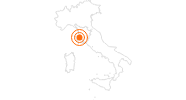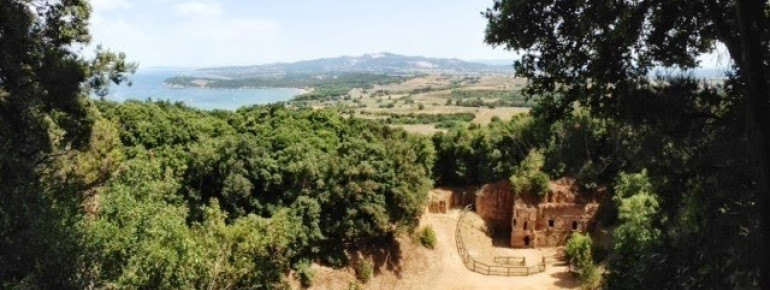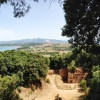Contents
Description
The compound of the archeological park in Baratti and Populonia is home of many sights, which can be explored on a guided tour or all by yourself via various hiking trails.
San Cerbone Necropoleis
For a start you can look around the San Cerbone Necropoleis, which are located close to the visitor's center. It'll take about an hour to explore Etruscan hills and aedicula tombs.
Grottoes – Necropolis
The Grottoes-Necropolis are situated on the hill at the golf of Baratti. Again it'll take about an hour to visit the rock-cut chamber tombs and the so-called panchina quarries, this place has to offer.
Center of experiential archaeology „Davide Mancini“
On your way to the Grottoes-Necropolis you will pass the center of experiential archaeology, where visitors may receive guidance on how to produce prehistoric items.
Visiting
On Via Akropolis you will get to the foothill's peak in about 50min and at the same time you can explore the remains of the Etruscan settlement. The tour does however not only offer cultural highlights but also a stunning view across the golf of Baratti and the island Elba.
Furthermore there are many trails on which you may explore the area:
Via del Ferro:
On Via del Ferro (trails are marked at the side of the road) you will get to the barrows and the antique buildings, which are closley connected to the ironworking in Populonia, in about 1,5h.
Via delle Cave:
Via delle Cave will lead you through the forests with the antique quarries in only two hours. A great view will emerge across the golf of Baratti and the Grottoes-Necropolis.
Via del Monastero:
On Via del Monastero you will get to the opposite hillside of the foothills in 2,5 hours. Hike to the medieval Benedictine monastery San Quirico and further to the acropolis.
Historical Information
Center of metalworking
Populunia has been the strategic place for Tyrrheanian shipping routes since the Ice Age, connecting Sardinia and Corsica with Etruria. Between the 6th and 9th century BC the town became the center of metalworking and processing hematite, in the Mediterranean. Hematite could mainly be found on Elba, an island in the golf of Baratti.
Uptown and Downtown
Populonia was devided into an uptown and a downtown, it had a port, which was located outside of the town wall and an acropolis on which you could find populated areas and temples.
The archeological area is still not fully developed but various pieces of evidence, which weren't yet found, give prove of the earliest settlements of the town.
The Necropoleis
The Necropoleis are gigantic barrows and aedicula tombs from the 7th to the 5th century BC. They belonged to the town's highest representatives. Furthermore you will find sarcophaguses from the 5th to 6th century BC and Etruscan rock-cut tombs from the 6th to the 3rd century. Also noteworthy are the panchina quarries. Panchina is a local sandstone, which was used for buildings, town walls and tombs.
Rome's influence
During the second century BC Populunia was politically influenced by Rome, which is shown by three huge temples and various roman style thermal baths.
Monastery San Quirico
Remains of the Benedictine monastery from the 11th century were found within the hills of the acropolis. Around the monastery was a cemetery, which implies that people still lived there even after the monastery's residents left.
Interesting facts
- Archeological Park of Baratti and Populonia is among the 3 best rated Tourist Attractions in the Toskana.
How to get there
By car:
The Archeological Park in Baratti and Populonia is located at the golf of Baratti close to Piombino.
Take SS Aurelia 1 and exit in San Vincenzo north. Then onto SP 23, the so-called „Strada Provinciale della Principessa“, which connects San Vincenzo and Piombino. From there simply follow the brown signposts.
You may enter the park from two different directions. One entrance is located on the street alongside the golf and the other one in uptown Populonia. We recommend the first mentioned entrance since there are many parking spots available and it is also closer to the Etruscan tombs.





